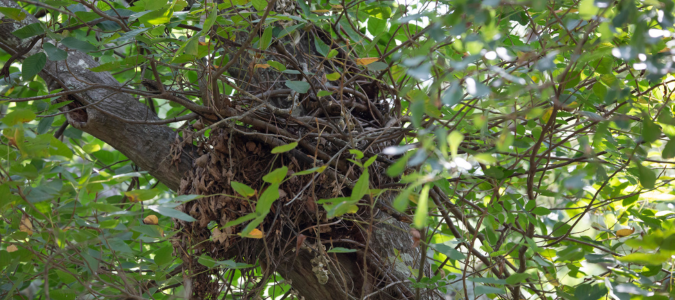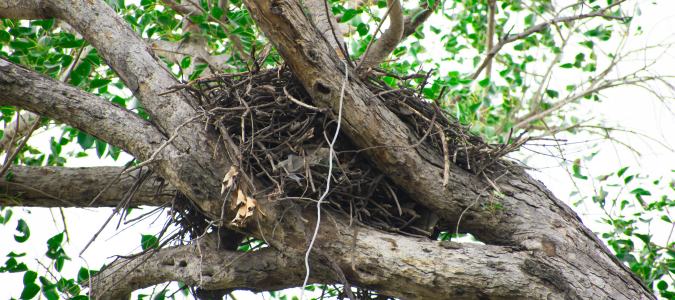Squirrels are persistent creatures that meticulously build their nests using all-natural materials. Squirrel nests are often camouflaged and difficult to tell apart from regular debris.
However, there are some easy ways to distinguish a squirrel nest, especially once you know more about squirrel behavior.
Squirrels can cause damage to your property, so it’s important to be vigilant about squirrel activity around your home. Call in a wildlife control specialist to control squirrels on your property.
What Does a Squirrel Nest Look Like?
Squirrel nests, also called dreys, can be challenging to identify because they often look like small, round bulbs of leaves and twigs bunched together. It’s common to mistake a squirrel nest for a random clump of debris. However, there are a few ways to tell a squirrel nest apart from debris.
For example, squirrel nests are built in specific locations where squirrels prefer to rest. They are often located in high places, such as in tree branches, attics or under the eaves of houses. Squirrels typically build their nests at least twenty feet in the air to stay safe from predators.
They also like to build nests in sheltered spots, such as inside an attic, to stay warm during the winter. They also veer towards sheltered spots when they are raising their young. When it comes to nesting in trees, squirrels choose branches with a solid base to support the nest, usually where the branches split off each other.
Understanding squirrel nesting locations is helpful for homeowners because it makes identifying the nests easier. It’s uncommon to see a squirrel nest on the ground, which is a quick way to distinguish nests from debris piles.
Next, single squirrel nests are often a standard size. They are round or oval-shaped nests that typically measure between twelve and eighteen inches in diameter. Sometimes, squirrels nest in groups, especially during the colder months. When that happens, they build bigger nests to accommodate their entire group.
Squirrels are creative creatures that use various natural materials to build their nests, such as leaves, twigs, small branches, strips of bark, grass and moss. They use leaves to form the outer layer of the nest and provide camouflage and insulation.
Next, twigs and small branches create the nest’s structure and maintain its stability. Strips of bark are often woven into the nest’s structure to add more support and insulation. Lastly, squirrels line the nest’s interior with grass and moss to create a soft and warm resting place.
Squirrel nests serve several purposes. They provide squirrels with a safe place to rest, store food and raise their young. They also protect the squirrels against harsh weather conditions, as they are generously built to keep squirrels warm in the winter and cool in the summer.
When to Contact a Wildlife Control Service
Squirrels look like innocent creatures but can cause significant property damage when they build their nests in or around your home. A wildlife control specialist can control squirrels on your property. If you spot a squirrel nest in or around your home, contact a local pest control company.
Just as it’s helpful to distinguish a squirrel nest from debris, it’s also useful for homeowners to distinguish various pests from each other. That’s why knowing how to tell a mole versus a mouse is helpful.
What Month Do Squirrels Nest?
Squirrels are busy creatures that build their nests throughout the year; however, there are certain seasons when they are more active than others. To understand their nesting patterns, you first need to learn about squirrel breeding seasons.
Squirrels have two main breeding seasons. The first one takes place in the late winter or early spring and the second one takes place during the summer. Squirrels actively build their nests during these periods to prepare to raise their young.
For example, after mating in the late winter, female squirrels immediately look for a secure spot to build a nest before giving birth. Squirrel nests offer a safe and warm place for baby squirrels, also known as kits, to spend the first few weeks of their lives.
Female squirrels nurture their kits for 10 to 12 weeks. After that, the baby squirrels are weaned, and the mother squirrel mates again in the summertime, typically between June and August.
It’s common to see more squirrel nests appear during these mating seasons. You may see them in your trees, attic, chimney or inside the eaves of your home. Squirrels can even build nests inside walls.
Another reason squirrels build nests is to store food for winter. You will begin to see squirrels preparing for winter during the fall months, typically from September to November. They use the time to fortify their nests by adding more materials, such as leaves, twigs, tree bark, grass and moss.
Some squirrel species build multiple nests in the fall as extra insurance for the winter months. If one nest is destroyed by predators or harsh weather, they can quickly shelter in their backup nest.
Squirrels are active most of the year, and their nests serve multiple purposes. You can spot squirrel nests at any point of the year, but nesting activity typically increases in the early spring, summer and fall seasons.
Squirrels can cause significant property damage, especially when they build nests inside the walls of your home. If you spot a squirrel nest inside or around your home, contact a wildlife control specialist to control them.
Mice are another pest that can cause property damage. Many homeowners find it helpful to know how to get rid of mice outdoors.
Where Do Squirrels Put Their Nests?
Squirrels build their nests in many locations, and the main criteria is that they are safe from predators and weather conditions. The three most common places for squirrels to build nests are in trees, attics and underground.
Squirrels prefer to build their nests in trees because the height offers ample protection from predators. Since their nests are made of leaves and twigs, trees also camouflage them, keeping them safe.
When choosing a tree to nest in, squirrels look for trees with dense foliage. Oak, pine and maple trees are all excellent options. The most common place to find a squirrel nest in a tree is where the branches split from each other because they provide a solid base for the nest to rest on.
Next, squirrels build nests in attics to stay safe from the cold during winter. They may choose your chimney or roof spaces for the same reason. When building nests indoors, the main criteria is that the spot is dry, warm, quiet and safe from intruders.
While most squirrels prefer to build their nests in high locations, some species build underground nests. Ground squirrels, for example, burrow several feet into the ground and build their nests in elaborate tunnel systems that include multiple surface-level entry and exit points.
Ground squirrels prefer loose, well-drained soil, so they often burrow around gardens, home foundations and lawns.
Squirrels can cause significant property damage when they build nests near your home. For instance, when squirrels build nests in your attic or chimney, they may create entry points by chewing through your home’s structure.
When squirrels build underground nests, they can wreak havoc on your lawn or garden. They can even damage your home’s foundation.
How to Deter Squirrels From Your Property
When choosing a nest location, squirrels look for three things: shelter from harsh weather conditions, protection from predators and access to food. Luckily, there are things you can do to make your property less appealing to squirrels.
First, trim tree branches back and away from your home. Then, seal up any holes that lead into your home, especially around your roof, eaves or vents, to reduce their access points further.
Remove squirrel food sources from your property, such as fallen fruit, nuts and seeds. If you have a bird feeder, make sure it’s squirrel-proof or in a location that is hard for squirrels to access.
Hearing them scurrying through your walls is a sure sign of squirrels in your home. However, it’s easy to mistake squirrel noises for mice. Experts can help you distinguish squirrel noises from mouse noises.
Control Squirrels With Professional Help
The best thing you can do when squirrels cause chaos on your property is call in wildlife control specialists. The experts can control the squirrel population and help you put prevention methods in place for the future.
ABC Can Get Squirrels Out of Your Home and Garden
It can feel defeating when squirrels are damaging your home, garden and yard. Instead of spending your precious time trying to control squirrels, contact ABC Home & Commercial Services. Our pest control professionals will create a custom treatment plan, so you don’t have to worry about these creatures.



